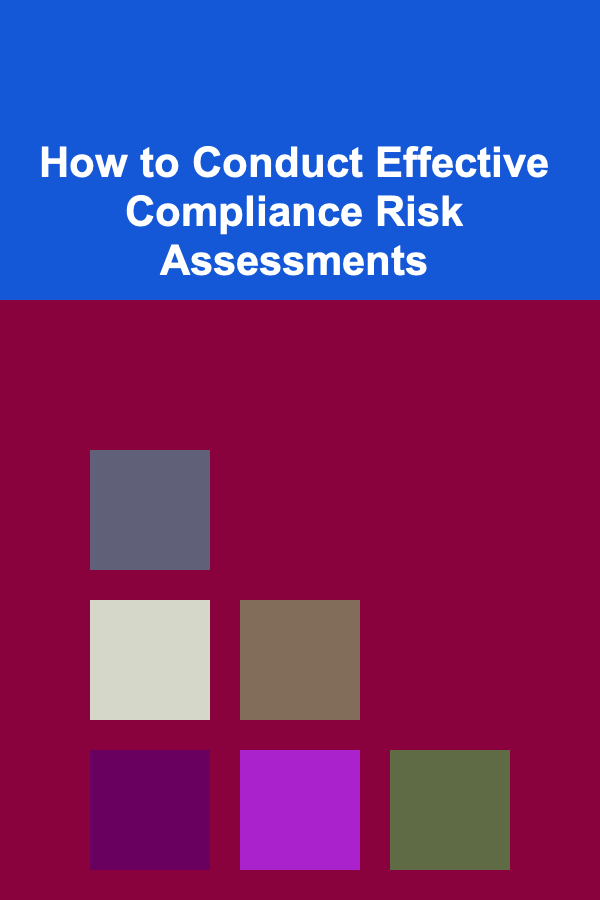
How to Conduct Effective Compliance Risk Assessments
ebook include PDF & Audio bundle (Micro Guide)
$12.99$11.99
Limited Time Offer! Order within the next:

Compliance risk assessments are a critical component of an organization's risk management framework. In an era where regulations are constantly evolving, organizations must not only be aware of legal requirements but also proactively manage the risks associated with non-compliance. The goal of a compliance risk assessment is to identify and evaluate potential risks to the organization's compliance with relevant laws, regulations, and internal policies. This process helps businesses mitigate risks, avoid penalties, and ensure that they operate ethically and transparently.
This article will delve into how to conduct an effective compliance risk assessment by outlining the fundamental steps, strategies, and best practices to ensure the assessment process is thorough, accurate, and actionable.
What is a Compliance Risk Assessment?
A compliance risk assessment is a structured process that identifies potential risks that could affect an organization's ability to comply with applicable laws, regulations, and internal policies. It involves evaluating the likelihood of non-compliance, understanding the consequences of such risks, and implementing measures to mitigate them.
The assessment not only helps organizations understand their exposure to various risks but also supports the design of effective compliance programs and controls. By assessing these risks, companies can prioritize areas for improvement and ensure they meet regulatory standards while reducing the potential for fines, sanctions, or reputational damage.
Step 1: Identify Regulatory Requirements
The first step in conducting an effective compliance risk assessment is to clearly identify and understand the regulatory requirements that apply to your organization. These requirements can vary depending on the industry, location, and nature of the business. For example, a healthcare organization will be subject to regulations such as HIPAA (Health Insurance Portability and Accountability Act), while a financial institution may need to comply with the Dodd-Frank Act and anti-money laundering regulations.
Key Considerations:
- Industry-Specific Regulations: Different industries are governed by distinct regulatory frameworks. For example, healthcare, finance, energy, and manufacturing have sector-specific laws.
- Geographical Jurisdictions: If your organization operates internationally, you must consider the regulatory requirements in each jurisdiction.
- Internal Policies: In addition to external regulations, internal company policies (such as employee conduct and reporting protocols) should be evaluated for compliance.
Once all applicable regulatory requirements are identified, the next step is to align these requirements with the organization's business processes.
Step 2: Identify Potential Compliance Risks
After identifying the regulatory requirements, the next critical step is to assess the various compliance risks that might impact the organization. Compliance risks can arise from various factors such as non-compliance with laws, employee misconduct, or inefficiencies in existing processes. These risks can have significant consequences, including fines, lawsuits, or reputational damage.
Types of Compliance Risks:
- Regulatory Risks: These risks arise from failure to comply with applicable laws and regulations. This could include violations of labor laws, tax regulations, or environmental standards.
- Operational Risks: These are risks associated with the failure of internal processes or controls that ensure compliance.
- Reputational Risks: A breach in compliance can damage the organization's reputation, resulting in a loss of trust from customers, partners, and investors.
- Financial Risks: These risks include the potential financial penalties, fines, or losses resulting from non-compliance.
- Technological Risks: Organizations also face risks related to their use of technology, including data breaches or failure to comply with cybersecurity regulations.
To identify these risks, it is essential to collaborate with various departments, including legal, finance, operations, and IT, as they may have unique insights into potential risks within their respective domains.
Practical Tools:
- Risk Mapping: A risk map can help visualize and prioritize compliance risks by considering their likelihood and potential impact.
- SWOT Analysis: This analysis can help identify strengths, weaknesses, opportunities, and threats related to compliance practices.
- Interviews & Surveys: Speaking to key personnel across departments can reveal hidden compliance risks that may not be immediately apparent.
Step 3: Evaluate and Prioritize Risks
Once the risks are identified, the next step is to evaluate each risk based on its potential impact on the organization. Not all risks are equal, and some may be more urgent or severe than others. This evaluation typically involves two main components: the likelihood of a risk occurring and the potential impact of the risk if it does occur.
Risk Assessment Matrix
A commonly used tool in this step is the risk assessment matrix, which categorizes risks based on their likelihood and impact:
- Likelihood: The probability that a given risk will occur (e.g., low, medium, high).
- Impact: The severity of the risk's consequences (e.g., low, medium, high).
By plotting the risks on a matrix, you can prioritize the risks that require immediate attention and allocate resources accordingly.
Risk Ranking:
- High Priority: Risks with a high likelihood and high impact should be addressed immediately.
- Medium Priority: Risks that are less likely to occur but have significant consequences if they do.
- Low Priority: Risks that have a low likelihood and low impact and can be monitored but do not require immediate action.
Step 4: Develop Mitigation Strategies
After evaluating the risks, the next step is to develop strategies to mitigate or manage these risks. Mitigation strategies are designed to either reduce the likelihood of a risk occurring or to minimize the impact if it does occur.
Risk Mitigation Strategies:
- Preventive Controls: These are proactive measures designed to prevent the risk from materializing. Examples include employee training, implementation of internal controls, and regular audits.
- Detective Controls: These measures are aimed at detecting risks in a timely manner, such as automated compliance monitoring tools, employee whistleblowing systems, and internal investigations.
- Corrective Actions: In the event of a compliance breach, corrective actions aim to restore the organization's compliance. This could include disciplinary action, process changes, or addressing the root causes of non-compliance.
- Transfer of Risk: In some cases, organizations may opt to transfer the risk to a third party, such as purchasing insurance or outsourcing certain functions.
The effectiveness of these strategies should be continually evaluated, and updates should be made as necessary. Additionally, mitigation strategies should be documented and communicated to relevant stakeholders to ensure consistent implementation.
Step 5: Implement Monitoring and Reporting Systems
Effective monitoring and reporting are crucial for ensuring that compliance risks are managed over time. After implementing mitigation strategies, organizations must establish systems to monitor ongoing compliance and track the effectiveness of their risk management efforts.
Key Components of Monitoring:
- Automated Compliance Tools: Implementing software that automates compliance monitoring can help ensure that your organization remains compliant with the latest regulations.
- Regular Audits and Reviews: Periodic audits allow you to identify any potential gaps or weaknesses in the compliance program and adjust strategies accordingly.
- Incident Reporting: Encourage employees to report compliance breaches or concerns, either through a formal reporting system or an anonymous hotline.
- Internal Communication: Create clear channels for communicating compliance expectations and reporting violations across all levels of the organization.
Regularly reviewing the effectiveness of your compliance controls ensures that the organization remains proactive in identifying and mitigating new risks as they arise.
Step 6: Create a Compliance Culture
One of the most important yet often overlooked aspects of a compliance risk assessment is the establishment of a compliance-focused organizational culture. A culture of compliance not only ensures that employees adhere to laws and regulations but also fosters an environment where ethical behavior is the norm, and risks are proactively managed.
How to Cultivate a Compliance Culture:
- Leadership Commitment: Senior leadership must demonstrate a strong commitment to compliance by setting the tone at the top. This includes modeling ethical behavior and holding themselves and others accountable.
- Training and Awareness: Regular training sessions and awareness campaigns help employees understand their roles in maintaining compliance and the consequences of non-compliance.
- Open Dialogue: Encourage open discussions about compliance risks and foster a transparent environment where employees feel comfortable raising concerns.
- Reward Systems: Recognize and reward employees who contribute to promoting compliance and ethical behavior within the organization.
A culture of compliance is essential for ensuring that the organization's compliance efforts are effective and sustainable in the long term.
Step 7: Document and Report Findings
Once the compliance risk assessment is complete, it is essential to document all findings and actions taken. This documentation should be thorough and include a record of identified risks, evaluated risk levels, mitigation strategies, and ongoing monitoring efforts. Not only is this documentation important for internal reference, but it is also crucial for demonstrating compliance to external regulators and auditors.
Key Documentation Points:
- Risk Assessment Report: A comprehensive report detailing the identified risks, evaluation results, mitigation strategies, and monitoring plans.
- Action Plans: Specific action items and timelines for addressing high-priority risks.
- Training Records: Documentation of any employee training conducted as part of the compliance risk assessment process.
By maintaining accurate and detailed records, organizations can ensure that they have a clear understanding of their compliance landscape and can easily demonstrate their efforts to mitigate risks.
Conclusion
Conducting an effective compliance risk assessment is an essential part of an organization's overall risk management strategy. By identifying and evaluating compliance risks, developing mitigation strategies, and establishing strong monitoring and reporting systems, organizations can significantly reduce the potential for legal and regulatory violations. Furthermore, by fostering a culture of compliance, organizations can ensure that compliance becomes an integral part of their operations.
Ultimately, an effective compliance risk assessment allows organizations to proactively manage risks, maintain regulatory adherence, and safeguard their reputation and financial health. By regularly revisiting and refining the compliance risk assessment process, organizations can stay ahead of potential risks and continue to operate with integrity and accountability.
Reading More From Our Other Websites
- [Organization Tip 101] How to Balance Personal Items and Professional Needs in Your Workspace
- [Home Budget 101] How to Budget for Travel and Save for Your Dream Vacation
- [Home Holiday Decoration 101] How to Create a Cozy and Festive Holiday Atmosphere in Your Tiny Apartment
- [Home Pet Care 101] How to Socialize Your Pet with Other Animals at Home
- [Home Budget Decorating 101] How to Add Personality to Your Home with Inexpensive Decor
- [Home Budget Decorating 101] How to Organize and Decorate Your Closet on a Budget
- [Home Rental Property 101] How to Conduct Thorough Rental Property Inspections
- [Personal Finance Management 101] Understanding Life Insurance Types and Costs: What You Need to Know
- [Personal Investment 101] How to Understand Stock Market Investing for Dummies and Start Building Your Portfolio
- [Organization Tip 101] How to Make the Most of Under-Sink Storage

How To Discover Breakthroughs in Bone Regeneration
Read More
How to Make a Time Capsule as a Gift for Someone Special
Read More
How to Make Your Rental Property Safe and Secure for Tenants
Read More
Top Tips for Buying Used Electronics and Getting the Best Deals
Read More10 Tips for Optimizing Your Retirement Income Tracker
Read More
10 Tips for a Job Search Checklist Tailored to Creative Freelancers
Read MoreOther Products

How To Discover Breakthroughs in Bone Regeneration
Read More
How to Make a Time Capsule as a Gift for Someone Special
Read More
How to Make Your Rental Property Safe and Secure for Tenants
Read More
Top Tips for Buying Used Electronics and Getting the Best Deals
Read More10 Tips for Optimizing Your Retirement Income Tracker
Read More